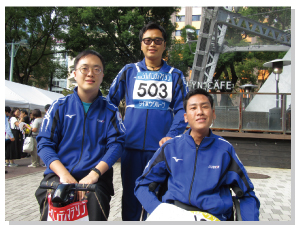Final Report
MyoMin's Final Report
Raising the awareness of persons with disabilities in Myanmar
The reason I applied for the Duskin Leadership Training Program in Japan
My name is Myo Min Htet. I am from Yangon.
There is a total of six present and former trainees from Myanmar, including myself. Currently three such former Duskin trainees are running a disabled people’s organization in Myanmar called Myanmar Independent Living Initiative (MILI). They are now serving the pioneering role in drafting laws and policymaking for persons with disabilities in cooperation with the government and engage in various kinds of disability related activities to promote awareness for persons with disabilities. Witnessing their efforts and achievements motivated me to apply for this training program. Thanks to the Duskin AINOWA Foundation, I got selected as one of the five trainees for the 20th Duskin Leadership Training in Japan.
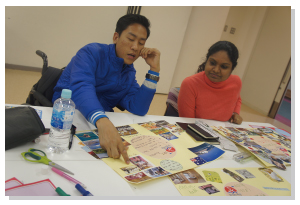
Japanese Language Training
I spent the first three months in Japan learning Japanese. Our teachers were Japanese and used only Japanese in the classroom, so we had to speak Japanese. Since I had studied Japanese for three months before coming to Japan, it was not difficult for me to study hiragana and katakana, but kanji was very difficult. Since our teachers had very good teaching skills I could easily understand and learn what they were teaching. The teachers were very patient with us and gave us strong support and encouragement. I felt more motivated and focused on my studies until my Japanese writing and speech improved.
Homestay
I spent 8 days with Mr. Tadashi Ono and their family, at their home in Niihama, Ehime Prefecture. It was the first time for me to stay with a Japanese family. I was really lucky to be with the host family who welcomed me as if I was their own son, and they made me feel at home right away, though I was in a foreign land, thousands of miles away from my own family and friends. There were 7 family members in the family including 3 lovely children. From morning to night, we enjoyed chatting, eating amazing, delicious Japanese food. They explained everything I was supposed to know and answered all my questions patiently. They also told me things I might be interested in so that I could learn plenty of new things about Japan’s culture and lifestyle. Whenever I hear someone mention Ehime Prefecture, the beautiful images and wonderful memories of the time spring back to my mind.
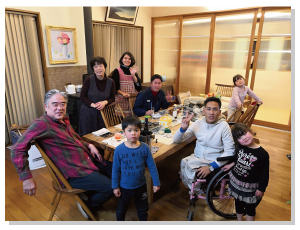
Ski Training
In late January, we the five trainees visited Echigo-Yuzawa, Niigata, to participate in a three-day ski training program. It was my first-ever skiing experience. I had never seen snow before. Before the training I had no idea how a person with a disability could ski, especially those who could not move their legs. But through this training I learned that even if we are severely disabled, given the right chance and enough support, we can do everything just like other people.
Skiing was one of the most unforgettable, happy experiences I ever had in my life.
Individual Training
After the homestay program, individual training programs started. These programs were the most important part of the whole Duskin leadership training program.
1. CIL DANNAI
At the beginning of my individual training, I went to CIL DANNAI in Nagahama City, Shiga Prefecture. Before coming to Japan, I had always thought that people with severe disabilities would be incapable of making their own decisions and unable to live an independent life, until I was proven wrong at CIL DANNAI. Even though all the members of CIL DANNAI had disabilities, they were all living an independent life with personal assistance. I visited some of their homes and saw how they were living, and could live, an independent life. I also experienced my first independent living at CIL DANNAI. Every night after my training, I talked with the DANNAI members about people with disabilities in Japan and Myanmar and shared our experiences. This helped me understand their life as well as their challenges.
2. Saito Kobo
Currently, the number of wheelchair users in Myanmar is on the rise. But there are no wheelchair maintenance or repair workshops in Myanmar. So, it is very difficult to repair a wheelchair once it is broken. This motivated me to learn about the maintenance of wheelchairs. Apart from the wheelchair maintenance, Mr. Saito also taught me about Japanese welfare system for those in need.
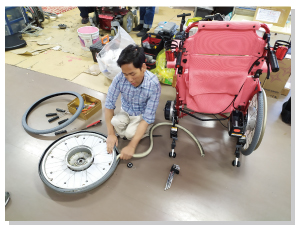
3. AJU Center for Independent Living (Nagoya)
At AJU I studied more about centers for independent living, and also about how to work and negotiate with society and local governments to get more support. During my stay at AJU, I had a chance to have dinner with Mr. Yamada who told me his life story which was extraordinary an inspiring. It gave me the confidence and energy I needed to devote myself and work hard for my future dreams. I learned about the employment of persons with disabilities at the Wadachi Computer House and Komaki Winery. The most unforgettable event during the training was participating in a barrier-free disability movement with other persons with disabilities.
4. Mainstream Association
I had such colorful, happy days at Mainstream Association, spending time with its members and staff who were so friendly. In such a short time, I learned many things from these wonderful friends, and my mentors Mr. Kadota and Mr. Hirata. I came to understand how Mr. Kadota and Mainstream’s members had originally established the association. Mr. Kadota went through such a hard time establishing the Mainstream Association but his achievement, which is creating accessible environment, is to be much appreciated. I learned, “The most important thing is to enjoy our life even if we are disabled”. Studying at Mainstream Association completely changed my view and thinking, to a positive one. Everyone at Mainstream had a clear purpose, was enjoying their job and taking responsibility for their individual role there. Despite severe disabilities, they were both working hard and enjoying life. The experience at Mainstream Association is full of many unforgettable moments and nurtured a great deal of confidence in me.
5. Center for Independent Living Movement
My last individual training took place at CIL Movement. It was the first time ever in my life living in an apartment, also living an independent life where I had to manage everything by myself. At Movement, I learned about discrimination against people with disabilities, how to overcome discrimination, and how to help people with disabilities live independently in their community.
The staff members of Movement were all young and fun, so we chatted about our lives, challenges and our future. I also visited various places with these friends. Among those experiences, I cannot forget the day when we went to a park to see blooming cherry blossoms. We had our lunch under the blossoms, immersing ourselves in Japanese O-Hanami, the best thing I ever experienced in my life. I also visited the Barrier Free Exhibition 2019. I gained a great deal of knowledge and understood the real meaning of barrier-free infrastructures.
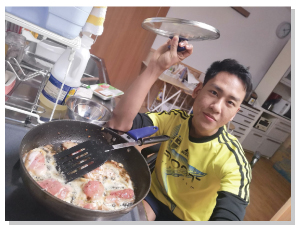
Barrier-free environment in Japan
I found Japan’s barrier-free environment amazing. In Japan, most of the buildings, transportations and products are accessible and barrier-free for persons with disabilities. The life of people with disabilities in Japan is extremely convenient. Now Japan is applying universal design to every construction and product. The Japanese disability movement of creating a barrier-free environment started decades back. It is ongoing and getting more powerful by the day. In Myanmar we have thousands of barriers which start from our doorstep, at our own home. Physically challenged persons are unable to even think of going outside as they wish to, and having no accessibility consequently slows down or hinders them from developing themselves.
My Goal after Returning Home
During my 10 months’ training programs I got to meet a great number of disability leaders and learned how the environment used to be in Japan, and how Japanese persons with disabilities struggled and drove disability movement. In my country, accessibility is a big problem, so my main goal is to negotiate with the government agencies about physical infrastructures, education, and accessible roads for all, to bring accessibility for all types of disabilities. As part of this project, I want to develop a barrier-free smartphone application for person with disabilities to point them to barrier-free places and provide the information they need. I also want to establish a counseling center for persons with disabilities to give advice and guidance on independent living. I also want to work on inclusive education, employment and welfare systems for persons with disabilities. Together with persons with all types of disabilities, I will participate in disability movement to promote public awareness for disability.
Gratitude
I would like to give my heartfelt, warm and sincere thanks to all the members of staff at the Duskin AINOWA Foundation, Japanese Society for Rehabilitation of Persons with Disabilities and Toyama Sunrise, all the teachers of our Japanese language classes, all the instructors of our swimming and ski training programs, homestay family, and everyone who welcomed me kindly at various training locations; volunteers and all my Japanese friends who made my stay a happy and fruitful experience.
My fellow 20th Duskin Leadership trainees are like a family to me. Living and spending time with them was an absolutely wonderful experience. It will be sad as we have to part and go back to our respective countries, but I will always cherish the memory of us together and always thank you from the bottom of my heart.
